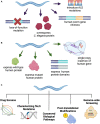Simple models to understand complex disease: 10 years of progress from Caenorhabditis elegans models of amyotrophic lateral sclerosis and frontotemporal lobar degeneration
- PMID: 38239833
- PMCID: PMC10794587
- DOI: 10.3389/fnins.2023.1300705
Simple models to understand complex disease: 10 years of progress from Caenorhabditis elegans models of amyotrophic lateral sclerosis and frontotemporal lobar degeneration
Abstract
The nematode Caenorhabditis elegans are a powerful model system to study human disease, with numerous experimental advantages including significant genetic and cellular homology to vertebrate animals, a short lifespan, and tractable behavioral, molecular biology and imaging assays. Beginning with the identification of SOD1 as a genetic cause of amyotrophic lateral sclerosis (ALS), C. elegans have contributed to a deeper understanding of the mechanistic underpinnings of this devastating neurodegenerative disease. More recently this work has expanded to encompass models of other types of ALS and the related disease frontotemporal lobar degeneration (FTLD-TDP), including those characterized by mutation or accumulation of the proteins TDP-43, C9orf72, FUS, HnRNPA2B1, ALS2, DCTN1, CHCHD10, ELP3, TUBA4A, CAV1, UBQLN2, ATXN3, TIA1, KIF5A, VAPB, GRN, and RAB38. In this review we summarize these models and the progress and insights from the last ten years of using C. elegans to study the neurodegenerative diseases ALS and FTLD-TDP.
Keywords: C. elegans; C9orf72; FUS; SOD1; TDP-43; amyotrophic lateral sclerosis; frontotemporal lobar degeneration; neurodegeneration.
Copyright © 2024 Eck, Stair, Kraemer and Liachko.
Conflict of interest statement
The authors declare that the research was conducted in the absence of any commercial or financial relationships that could be construed as a potential conflict of interest.
Figures

References
-
- Alexander-Floyd J., Haroon S., Ying M., Entezari A. A., Jaeger C., Vermulst M., et al. . (2020). Unexpected cell type-dependent effects of autophagy on polyglutamine aggregation revealed by natural genetic variation in C. elegans. BMC Biol. 18:18. doi: 10.1186/s12915-020-0750-5, PMID: - DOI - PMC - PubMed
Publication types
Grants and funding
LinkOut - more resources
Full Text Sources
Research Materials
Miscellaneous

